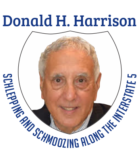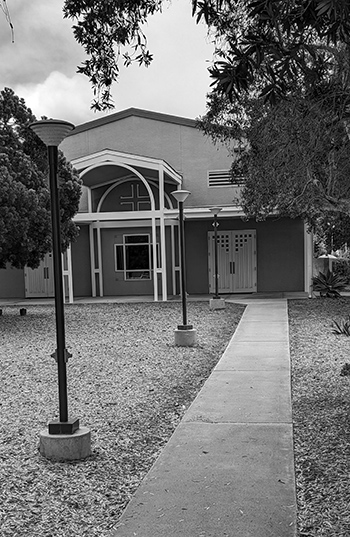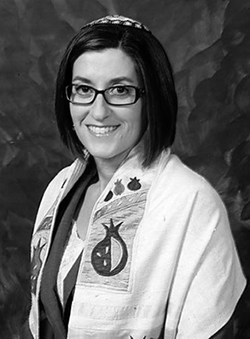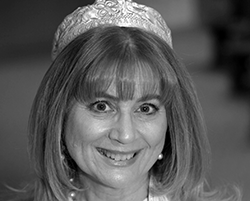 Editor’s Note: This is the 22nd chapter in Volume 3 of Publisher and Editor Donald H. Harrison’s 2022 trilogy, “Schlepping and Schmoozing Along the Interstate 5.” All three books as well as others written by Harrison may be purchased from Amazon.com.
Editor’s Note: This is the 22nd chapter in Volume 3 of Publisher and Editor Donald H. Harrison’s 2022 trilogy, “Schlepping and Schmoozing Along the Interstate 5.” All three books as well as others written by Harrison may be purchased from Amazon.com.
Schlepping and Schmoozing Along the Interstate 5, Volume 3, Exit 50 (Carlsbad Village Drive): Temple Etz Rimon
From northbound Interstate 5, take the Carlsbad Village Drive exit and turn right (east) to a right turn on Monroe Street. Follow Monroe Street past Carlsbad High School to Chestnut Avenue. The Pilgrim Church and Temple Etz Rimon are at 2020 Chestnut Avenue, at the intersection with Monroe Street.


Besides social action programs, several aspects of Temple Etz Rimon stand out. First, its mainly elderly congregants go out of their way to make newcomers welcome. Second, the church and temple membership have found numerous ways to help each other. Third, the temple membership has a decided interfaith flavor.
Barbara Browne, who was the founding president of Temple Etz Rimon in 2000, said many of the mostly elderly congregants who joined Temple Etz Rimon didn’t want to drive as far as Encinitas, where Temple Solel is located, nor to Poway, where another large Reform congregation, Temple Adat Shalom, is situated.
Initially, the congregation met at the Carlsbad Women’s Club but when scheduling conflicts precluded regular Friday night Shabbat services, Temple Etz Rimon (Pomegranate Tree), accepted an invitation from the Pilgrim Church to hold services there. “They said, ‘Come down and have services; we won’t charge you.’ We said, ‘No, that’s not the Jewish way,’ so we paid,” Browne said. “I think we started at $50 a month, and that increased over the years. We told them that their congregants would always be invited to our Friday night services and some of them used to come. They loved it. They were very helpful to us.”
Browne had start-up congregations in her blood. Her grandparents, Abraham and Marsha Cohn, started an Orthodox synagogue in Long Beach in 1923 that eventually became the now defunct Conservative Temple Sinai. Her husband, W. John Browne, was a member of a Methodist Church in Anaheim that hosted a start-up Jewish congregation in that city.
“My husband wanted to convert,” Browne recalled. “I said, ‘Why? You go to services with me, you helped me build the temple. You have done everything.’ I didn’t want to hurt his mother’s feelings. She was a wonderful woman and I loved her, and she respected me as her number one daughter-in-law. When she would come down here, she would stay with us (in Vista) for two to three months at a time and she would go to services with me. I respected her; I knew she never wanted him to be converted. And then he said, ‘I won’t do it while she is alive’ and she lived a long time.”
The Brownes had four children, all of who were bar or bat mitzvah. From those four children, the Brownes kvelled over a total of 14 grandchildren, all of whom became b’nai mitzvah.
Under Barbara Browne’s leadership and that of such successors as Eitan Aharoni and Marilyn Clement, “every month, we had a charitable thing that we did. One time we collected good books, and it was sent on a ship that was going to war, 500 books for the ship’s library,” Browned recounted. “Another time, we found that the young mothers who were having babies with the enlisted men at Camp Pendleton didn’t have any outfits for the babies. So, everybody came on a Friday night with new outfits that they had purchased. Every month, I made a different commitment to something. I didn’t care about being president; I cared about social action. Tzedakah (charity, justice) was the most important thing.”
Some of the tzedakah was focused on upgrading the building that they and the Pilgrim Church shared. ‘We remodeled the kitchen,” Browne said. Temple Etz Rimon also worked together with Pilgrim Church on winter Interfaith Homeless Shelter programs when homeless families are housed for two weeks at a time at churches and synagogues around the county.
Ruby Farber, another founding member of Temple Etz Rimon, recalled an occasion when the church and the temple held a joint auction. The proceeds were used to “redo their cooling system – not air conditioning but some sort of cooling system.”
Because the church holds services on Sundays and the temple holds services on Friday nights and some Saturday mornings, there was no conflict over worship times. The temple was even able to hold Sunday school in the afternoons, after the churchgoers went home. Now, because membership has shrunk from 70 to approximately 50 in the wake of the COVID-19 pandemic, the temple no longer has the resources, nor a young enough membership to offer Hebrew school.
Farber recalled when the congregation first got started, she visited Rabbi Wolli Kaelter of Temple Israel in Long Beach, where she had worshiped previously. Rabbi Kaelter had compiled a High Holy Days machzor in a looseleaf notebook, which he allowed her to photocopy. Marilyn Clement used some of the rabbi’s collected prayers and readings and added to them others that she had collected for use at the nascent congregation’s first High Holiday services. Both Kaelter and Clement have since passed away.
Not long after Farber brought the notebook back from Long Beach, her husband Stuart had to be hospitalized in intensive care, precluding Rub’s active participation in the congregation for the next ten years prior to his death. Following Stuart’s passing, Ruby became active again, serving two years as Sisterhood president. She was also a member of the Temple board.
Helping the congregation over the first decade were guest rabbis starting with Mel Weinman, and including David Barnett, Mark Goldfarb, Ben Kamin, Bernie King, Hillel Cohn, and Arnold Kopikis. A pomegranate was pictured on a tapestry that could be pulled down from the ceiling to hide the cross during Jewish prayer services.

In 2009, the congregation hired Rabbi Karen Sherman as a permanent part-time rabbi. “The kids followed her around,” recalled Farber. “For Purim, she wore the silliest costumes. She was right there with the kids, who loved her. There are grown kids who remember her from growing up and now as teenagers still recognize her.”
Sherman used to commute from Orange County to Carlsbad for three or four days a week. When she accepted a job in 2019 with Heritage Pointe, a Jewish communal senior residence in Mission Viejo, worried Temple Etz Rimon congregants asked, ‘what will we do now?’ Farber recalled. A friend told her before Cantor Bromberg was hired, “I don’t have to worry, Rabbi Sherman will do it.” As it turned out, that wasn’t necessary. For the following three years, Cantor Caitlin Bromberg served as a part-time spiritual leader while attending rabbinical school at the Academy for Jewish Religion California (AJRCA) in Los Angeles.
Every synagogue has its own personality. Farber said that Temple Etz Rimon’s is that “it is very, very friendly. Warm. You come into the building and you are greeted. You are welcomed at the oneg. They grab you; they love you. People will say, ‘Oh my God, you are so friendly!’ We are. There is no snobbishness in the group. It’s really a nice congregation. Unfortunately, it is getting smaller and smaller.”
Another original congregant, Lizz Goldman, who serves as the congregation’s administrative assistant, suggested that Temple Etz Rimon is like the Cheers bar of television fame, where everyone knows your name. “Since I am the keeper of the phone, I am usually the first contact that people have with the congregation. Someone asked, ‘How will they know I am there?’ and I told her, ‘Whenever someone walks in, there are probably three people who will come up to you and welcome you, asking what’s your name and how can we help you. They will sit with you.’ And she said, ‘That is wonderful.’ We really try to do that because it is important. If someone walks in and no one talks to them, they’re not coming back if they stay at all. We try to be very welcoming. We all have been new at some point. So, we know how they feel. We are small but we have a really big heart.”
Rabbi Sherman echoed Goldman’s comments. “I remember when the board got together to develop a mission statement,” she said. “One of the things we wanted to say was ‘we are warm and welcoming: we’re inclusive.’ At that time the URJ (Union of Reform Judaism) said, ‘Well you can’t say that because everyone says they are warm and welcoming. That is so cliché now.’ We said, ‘But we are really warm; for us it is really true. People feel included. At the weekly Oneg Shabbat (refreshments following a Friday night service), people talk to everyone. It is too small for little cliques. People don’t stay secluded in their own small groups. It’s like a big family.”
Brown was 89 when interviewed in June 2022. Farber was 83. COVID-19 was one reason why more and more of the elderly members stayed away from in-person services, either preferring to watch them on Zoom or skip them entirely. Other congregants did not want to drive to 7 p.m. services and return home when it was dark. Another reason for shrinking membership, said Farber, is that ever since antisemitic gunmen invaded the Tree of Life Synagogue in Pittsburgh, killing 11 persons, and the Chabad of Poway, killing one congregant, people like her have become afraid to go anywhere. “I look around to make sure that I am safe,” Farber said. “I don’t follow the service. I’m worried that someone will come in and start shooting!”
Goldman recalled that Pilgrim Church’s spiritual leader, Rev. Madison Shockley, was a “Godsend” after the 2018 attack on the three combined congregations at the Tree of Life Synagogue in Pittsburgh. “Everyone was concerned for everybody’s safety and Madison came to us and said, ‘The church board said we will sit outside your services and be there to protect you.’ We thought that was such a wonderful gesture to make.”
Rabbi Sherman recalled that when she came to Temple Etz Rimon, “I was just starting out as a rabbi at that point. Pastor Madison Shockley reached out to me. We had a very nice, collegial relationship. He was a really kind mentor to me. He was not a rabbi, of course, but we deal with the same kinds of things. All the congregants were very gracious, generous, and hospitable. They were very welcoming to us.”
The tzedakah programs the two congregations participated in were “a natural progression for me. I grew up doing that. It was just what we do,” Sherman said. Like many congregations, “we collected food on Yom Kippur, so on our day of fasting, people would bring in canned food, non-perishable items that we would donate. We also did a gleaning project at one of the local farms.”
Additionally, she recalled, ‘we participated in the One Warm Coat program, where people would donate used coats. At Chanukah time, we would ‘adopt’ families, where our families would give gifts, eventually gift cards, to families in need. We had junior and senior high school youth groups; those kids also participated in some social action activities.”
One year, Rabbi Sherman related, “We hosted a Passover seder and invited members of Pilgrim Church. This was really a meaningful highlight of our interfaith relationship. It helped promote mutual understanding of our respective traditions and history. It also was just a lot of fun and helped develop positive social relationships between our congregants.”
Sherman grew up at Temple Beth Sholom (House of Peace) in Santa Ana, and her husband, Harvey, grew up at Temple Beth Tikvah (House of Hope) in Fullerton. “We met in high school and one or the other of our congregations was always doing a social action project when we were dating. We were on the national Reform Jewish youth board, and I was vice president for social action. I went on to become a social worker. That is where my passion for Judaism really started with social action.” Their two daughters followed in their Jewish footsteps. At the time of our interview one daughter was a Jewish community teacher in Northern California while the other was taking Jewish Studies at the University of British Columbia and working at the Jewish Federation in Vancouver.
Sherman said she and Pastor Shockley on one or two occasions spoke to each other’s congregations. When she addressed his church, she said, she drew inspiration from four colorful banners that hang in the church’s courtyard. They say, “Community,” “Progressive Theology,” “Spirituality,” and “Social Justice.”
“I walked on their campus for the first time, and I thought those values really reflect our Jewish values, so when we talked, we focused on those things in common, those areas of common interest and passion.”
When Temple Etz Rimon conducted High Holiday services, Sherman recalled one of the Pilgrim Church’s congregants operated the temple’s sound system. Church members also learned about Sukkot after Temple Etz Rimon erected a sukkah on their grounds. They witnessed a tree being planted on their grounds one Tu B’Shvat. And when Pilgrim Church erected a sign at the corner of their lot, it included not only the church’s name but also that of the temple.
Sherman said she loved being the rabbi at Temple Etz Rimon, but she found the commute down the Interstate 5 difficult, especially when either the San Diego County Fair or Del Mar Thoroughbred horseracing were in session. She sometimes would leave Orange County several hours earlier to avoid the congestion.
When a job at Heritage Pointe was offered as rabbi, chaplain, and part of the overall health care team, Sherman could not resist. It was only 20 minutes from her house.

(Photo: L’Chaim San Diego Magazine)
For her successor, Cantor Caitlin Bromberg, a part-time job at Temple Etz Rimon was a San Diego County homecoming. Her parents were attorney Stacey Sullivan and Old Globe Theatre actress and educator Diane Sinor, whose second marriage was to the folksy Evening Tribune columnist John Sinor, who wrote about everyday things happening to everyday people.
Sullivan, who died at the beginning of 2022 at age 95, was credited as instrumental in persuading Baron Hilton to move football’s Chargers in 1961 from Los Angeles to San Diego, a move that was reversed 56 years later when the National Football League team moved back to Los Angeles on the decision of owner Dean Spanos. Sullivan also was very active at the Old Globe Theatre, leading the drive to rebuild it after an arsonist burned down in 1978. He also was the president of the Friendly Sons of St. Patrick.
Diane Sinor was an actress at the Old Globe Theatre when she met John Sinor as a fellow cast member in Spoon River Anthology. When Diane’s six children and John’s five children combined into one large family, the Sinors compared themselves to the fictional Brady Bunch on television. One of Caitlin’s stepbrothers, Mike Sinor, became a priest, serving in 2021 as Director of Spiritual Formation at St. Francis Seminary at the University of San Diego.
Although raised as a Catholic, Caitlin as a 12-year-old found herself disillusioned by the Catholic Church in the wake of Stacey’s and Diane’s divorce in 1969. “I was absolutely convinced that the Church had lost its way on this,” she said. “I thought that what was happening in my family was what should happen, and I thought God thought that too.”
That was what started Caitlin’s spiritual quest that ended up with her converting to Judaism, first in a Reform ceremony and later in an Orthodox ceremony. “The first book I read (about Judaism) was Exodus by Leon Uris. The second was Jews, God and History by Max Dimont. That was way over my head, but I read it anyway. So, I started with fiction which is associated with the drama of the Holocaust and the founding of the State of Israel, and then I read a history book. I always had been interested in biblical archaeology or Near East archaeology, so there was a kind of melding of different interests. When I discovered that Judaism had a very practical approach to divorce, I wanted to know more. I discovered that the Jewish way of creating community and supporting families was much more in line with what I thought made sense. That was the beginning. There was a background of family trauma but my response to it was to look beyond the Church that I had been raised in for another spiritual path.”
In her own adulthood, Caitlin would marry and divorce two Jewish men. The first, the late David Kleiman, a musician, felt uncomfortable because he thought Caitlin too religious. “He didn’t want to go so regularly to Shabbat services.” The second, the Orthodox David Bromberg, on the other hand, was uncomfortable with Caitlin taking such a pro-active role in Torah study and other areas of Judaism that in Orthodoxy traditionally have been reserved to men.
In a June 2022 interview, she credited both of her former husbands, nevertheless, with having contributed to her growth as a Jew, although such female mentors as Rabbi Sally Priesand and Cantor Ellen Stettner at the Stephen Wise Free Synagogue on Manhattan’s Upper West Side were more influential as mentors.
“Both my husbands were well-educated and passionate Jews as well as influential to my Jewish growth in important ways,” she stated. “My first husband was my mentor in Jewish music, and my second opened up the world of Talmud and Kabbalah for me.”
“I converted to Judaism when I was 26” after graduating with a major in theatre from UC San Diego, Cantor Bromberg related. “I was living in New York, doing things in theatre and started singing, especially in Irish pubs. My father is Irish. I was doing a lot of Irish music and British Isles music, and I met a whole lot of Jews who loved that music. My social circle had a lot of Jewish folk musicians in it.”
Previously she had explored various spiritual paths, including those of Druids and the early Celtic world, but “my interest in Judaism bubbled up again when I had contact with these people and also because I was in New York where the Jewish world is so much more obvious and rich. Occasionally, I joked that I ended up in a Jewish theme park. If you were ever going to be some place to explore Judaism, this was the place to be. Although I am a native Californian, I am sort of a New York Jew.”
Her first husband, David Kleiman, was a member of the Stephen Wise Free Synagogue, which had hired the first woman to be ordained as a rabbi, Sally Priesand, to be their assistant rabbi in 1979. “When I decided it was time to learn a little bit more about Judaism and start pursuing conversion, hers was the office I was sent to,” Bromberg related. “So, the very first contact I had one-on-one with a rabbi was with a woman rabbi. From the beginning of my Jewish life, I had female role models. Jewish women my age (mid 60s in 2022) generally didn’t start with that. They also hired one of the first female cantors to graduate from Hebrew Union College, Ellen Stettner, and she became my first cantorial mentor. One of the things that is unique about cantorial music, and all Jewish music, is that it is a combination of something that is indigenous, very close to the kishkes (guts) and also a high art. At the time I had been studying Italian opera, and I didn’t find those characters quite as compelling. I couldn’t imagine myself spending my whole life playing those characters.”
She was converted in a Reform ceremony in 1981 and not long afterward applied for cantorial school at the HUC. In essence, “HUC said, ‘Little girl, go away and be Jewish a little longer. You can’t go from square 1 to square 25.’” However, one of the faculty agreed to coach her informally so if she worked as a cantorial soloist, she would do it right. Within a short time, she was hired to lead High Holy Day services at the Jewish Family Congregation in South Salem, New York. “The first time I chanted Kol Nidre (All Vows), I had been Jewish for nine months,” she remarked. She remained with that congregation for three years.
While it was energizing to be the leader of a congregation, the cantor realized that there was a lot about Judaism that she didn’t know. “I started exploring traditional Judaism—Conservative and Modern Orthodox—and that started the phase of my traditional Jewish journey. Five years after my Reform conversion, I did an Orthodox conversion in Boro Park, Brooklyn. I had an invisible OU (Orthodox Union) on my forehead.’
Rabbi Gedalia Schwartz, who was on the Orthodox va’ad (group) that supervised kosher observances in the area, was the son of a woman who “was very highly educated and knew Talmud, and he had a lot of respect for women’s learning,” the cantor said. During the years that she was Orthodox, she was married to David Bromberg and gave up public singing.
Discussing her two divorces, she said, “What I liked about Judaism is there is an acceptance that marriages don’t always work out and if that is the case, what the community should do is support the couple in their transition rather than turn them away. Because of the get (formal divorce) ceremony, you have ritual that helps you with closure and helps you with moving on.”
“Perhaps,’ she reflected, “it is a good thing to know that there are also single, divorced, or otherwise unpartnered people within the rabbinate. We are all in it because we love our stiff-necked, somewhat wayward people, we are deeply compassionate as well as intellectual, and we love the fun of being observant Jews and introducing and encouraging others in Jewish practice. I think all clergy struggle with the work-life balance whether married or single.”
Cantor Bromberg decided to apply again for cantorial school, this time at the Jewish Theological Seminary of the Conservative Movement. She was accepted, graduated, and became a member of the Cantors Assembly in 2000. She served Congregation B’nai Zion in El Paso for four years and Congregation B’nai Israel in Albuquerque for another four years. Having felt Jewishly isolated in the Southwest, she accepted a cantorial position with Temple Israel in Ridgewood, New Jersey.
“The stock market crash and the impact of the Bernie Madoff scandal—which robbed many Jewish institutions of their investment capital—led to her being asked to work parttime in her fourth year there and the elimination of the cantorial position in her ninth year. In 2016, she was hired by Temple Hatikvah (Hope) in Flanders, New Jersey, for one year not as a cantor but to serve as the interim spiritual leader, in essence as the rabbi.
Bromberg’s second marriage produced a son, Rafi, who followed in her path as an actor and a singer. “He is now 35 years old and his years of being ‘oy, it’s the cantor’s son!’ did not make him an engaged Jew,” the cantor commented. “I didn’t push him after his bar mitzvah, not wanting him to develop the ‘preacher’s kid’ syndrome. He has a strong Jewish identity, he loved going on Birthright, and he is very knowledgeable about both American and Israeli politics. He is a retail specialist at the Apple Store in Short Hills, New Jersey. When I relocated to San Diego, he decided to stay in New Jersey.”
Bromberg decided to relocate to San Diego County in part because her father was ailing. “My first year here, I taught Hebrew School at Congregation Beth Am and did some part-time cantorial work for the Elijah Minyan, headed by Rabbi Wayne Dosick, a friend and a mentor. He was one of the people who encouraged me to come to San Diego. My second year here, I became the interim rabbi at Ner Tamid Synagogue and was there during that year – referring to the murder of 11 people at the Tree of Life Synagogue in Pittsburgh, Pennsylvania, and of Lori Gilbert Kaye in a later shooting attack at Chabad of Poway. “It was the second time I had served as an interim rabbi. So that was when I started rabbinical school. I was pretty sure that was the direction. And the following year, 2020, I was hired by Temple Etz Rimon, and it has been fun to come back to the Reform movement.”
As in the situation in New Jersey, shrinking attendance at Etz Rimon forced the congregation to eliminate Cantor Bromberg’s position in the Summer of 2022, although they agreed she would conduct High Holy Day services later that year and be available on a fee-for-service basis for other events. She subsequently signed on to serve as the interim rabbi on a part-time basis at Temple Beth Shalom in Long Beach, California, necessitating a move closer to that congregation. Bromberg also was engaged to lead one Shabbat service a month at B’nai Chaim (Children of Life), a Conservative congregation in Murietta, California.
Looking back on her tenure at Temple Etz Rimon, Cantor Bromberg said that when two congregations of different faiths share a space, there can be an inevitable awkwardness. “I know that once I took the Torah out to look at it, and I unrolled it on their marble table. Then, all of a sudden, I was worried that I committed a sacrilege. You never quite know.”
However, she said, social action projects and parallel progressive philosophies “united us very much in our hearts.” She noted that the Pilgrim Church has an annual service in memory of people who succumbed to HIV/AIDS. “They have a beautiful quilt that was made many years ago. It has individual people’s names. It is this beautiful, decorative textile, and when we come into the space, we feel just really happy seeing it. We are all on the same page.”
*
Donald H. Harrison is publisher and editor of San Diego Jewish World. He may be contacted via sdheritage@cox.net